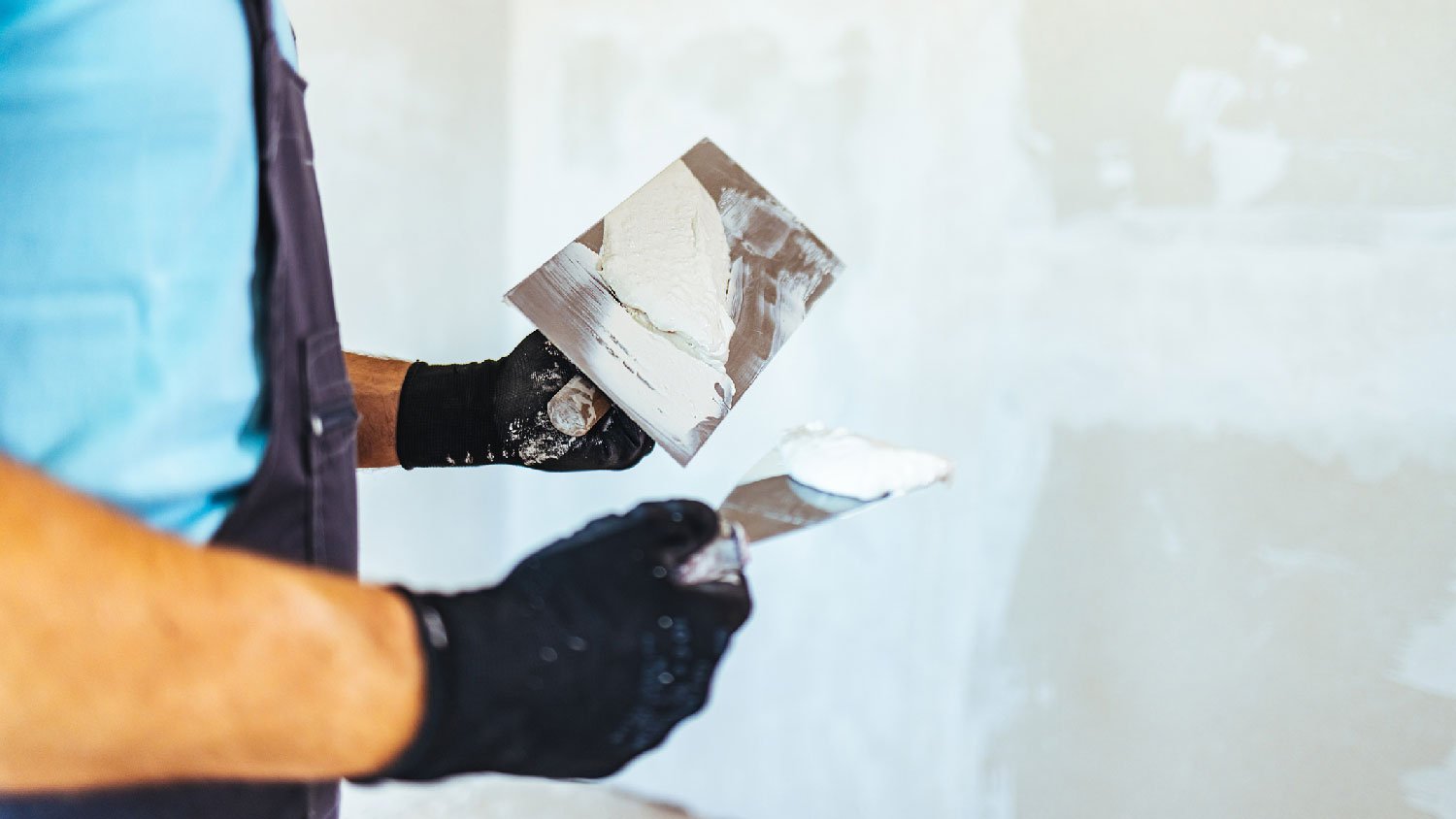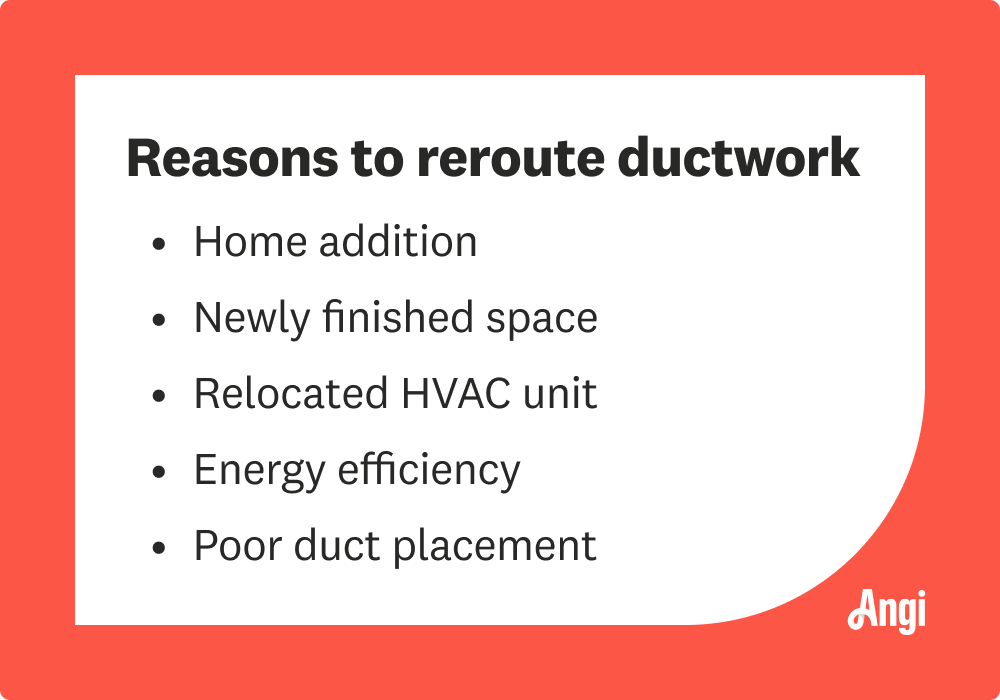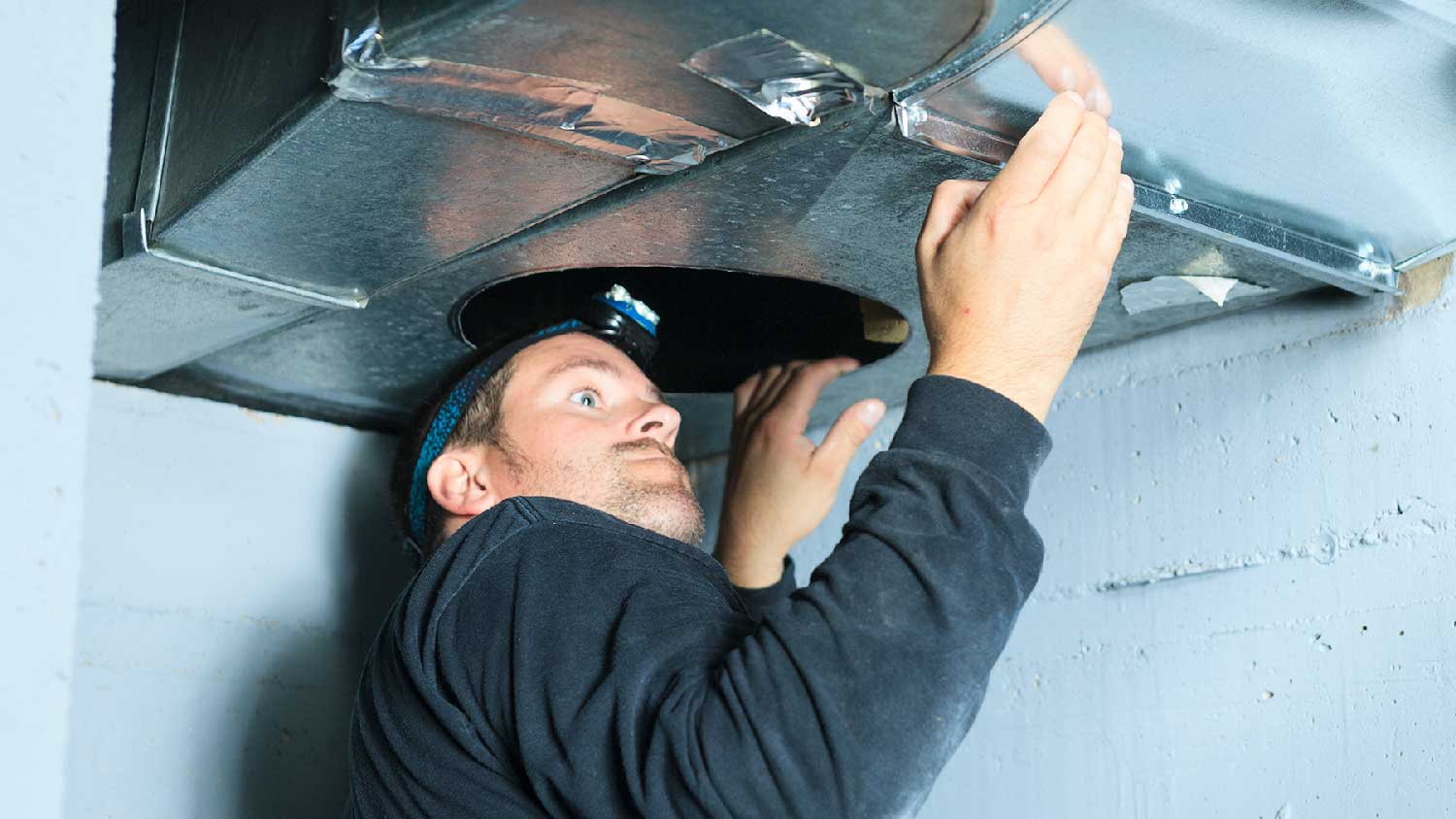
A faulty evaporator coil is a common cause of AC failure. But how much does an evaporator coil replacement cost? We explore the factors here.
The average cost to reroute ductwork is $4,500, but can increase based on your duct material and home size.


Ductwork costs depend on the material—Non-insulated flexible ductwork costs $1 to $3 per foot, while an insulated version costs $2 to $4 per foot.
If you are hiring pros to reroute your ductwork, expect them to charge $5 to $10 per foot for labor.
Don’t forget to consider costs associated with new vents, drywall repair, and any required HVAC inspections.
If your newly modified ductwork means modifications to the existing return air drop, it can add between $300 and $400 to the overall project.
The cost to reroute ductwork for a 1,000- to 2,500-square-foot home, including labor, can fall between $1,500 and $9,000, with the average cost falling around $4,500. Whether you're planning a home renovation or addressing HVAC system issues, understanding the expenses involved is crucial. We'll explore the factors that influence the overall cost, additional factors to consider, and some money-saving tips.
Let's dive deeper into the various components that make up the overall cost of rerouting ductwork. Understanding these elements will help you plan your budget effectively.
Rerouting ductwork often requires additional duct materials to be installed. The type of ductwork material you choose can significantly impact the overall cost. For example, non-insulated flexible ductwork costs between $1 and $3 per linear foot, whereas durable sheet metal ductwork can cost as much as $13 per linear foot.
| Material | Cost per Linear Foot |
|---|---|
| Non-insulated flex | $1–$3 |
| Insulated flex | $2–$4 |
| Fiberglass | $4–$6 |
| Sheet metal | $7–$13 |
The length of new material required for moving your ductwork is another crucial factor when determining the cost to reroute ductwork. Since duct materials cost between $1 and $13 per linear foot, making your ducts longer means higher costs.
A return air drop is a duct that serves as the pathway for air to return from the living spaces back to the HVAC system for reconditioning. It’s typically equipped with filters to remove dust and contaminants before the air re-enters the HVAC system, contributing to improved indoor air quality. If your newly modified ductwork means modifications to the existing return air drop, it can add between $300 and $400 to the overall project. If a second return air drop needs to be installed, the cost could be as much as double that.
Labor costs are a significant part of rerouting ductwork expenses. Ductwork installers typically charge between $5 to $10 per linear foot for labor alone. Extensive duct rerouting projects or situations where the ductwork is in a less accessible location—like a small crawl space—may require more labor or specialized tools.

When rerouting ductwork, it’s possible that walls and ceiling will need to be opened up. Be sure to budget for this type of aesthetic restoration, including the cost of drywall repairs—which average between $150 and $330—as well as ceiling fixes, which can range from $300 to $1,200.
| Aesthetic Repair | Cost |
|---|---|
| Drywall repair | $150–$330 |
| Ceiling repair | $300–$1,200 |
Discovering mold or asbestos during the ductwork rerouting process can be a costly surprise. Prior to any rerouting, schedule an HVAC inspection to uncover any harmful issues and facilitate their safe removal. While these steps are vital for a healthy living environment, they do add to the overall project cost:
Cost of asbestos testing and inspection: $250 to $700
Cost of mold inspection and testing: $200 to $650
Cost of asbestos removal: $700 to $2,200
Cost of mold remediation: $450 to $6,000
Obtaining the necessary permits is often a mandatory step in rerouting ductwork. We'll explain the permit requirements and associated expenses.

There are various reasons why homeowners should consider rerouting ductwork. One of the most common reasons is poor placement. This happens when the original ductwork isn't configured optimally, which can cause certain spaces to lack proper heating, cooling, and airflow.
Another reason to reroute ductwork is air leaks caused by worn-out areas and poorly connected ducts. Although patching leaks can help, rerouting is sometimes necessary to ensure the ductwork's position doesn't make it vulnerable to future leaks.
Rerouting your home's ductwork has a huge benefit of maximizing energy efficiency, which translates to long-term cost savings.
Other perks of rerouting ductwork include improved household air quality, moisture control, and more comfortable temperature control.
Quality ductwork will increase the efficiency of your HVAC, sometimes by 20% to 30%. This is because there is reduced air leakage due to better insulation and more optimized airflow. This means your HVAC doesn't have to work as hard to keep the desired temperature, so it uses less energy.

Deciding between a DIY ductwork rerouting and hiring a professional largely depends on your skills, comfort level, and the complexity of the project. For straightforward rerouting jobs, DIY may be possible and can certainly save money. However, if the project involves intricate adjustments, permits, or safety hazards like asbestos, hiring a local air duct installer is crucial.
Professionals bring expertise, ensure compliance with local regulations, and guarantee quality work. Weigh the pros and cons carefully, keeping safety and long-term results in mind when making your choice.
There are some common add-ons associated with the cost to move HVAC ductwork, and these additions can enhance the efficiency of your HVAC system or improve indoor air quality.
| Add-On | Cost |
|---|---|
| HVAC inspection | $70–$500 |
| Air duct cleaning | $150–$700 |
| Duct insulation | $1–$6 per sq ft |
| Adding vents | $250–$500 |
Regular professional inspections are essential to ensure your system functions optimally. You may need inspections prior to or after rerouting your ductwork to ensure the absence of harmful substances as well as the efficiency of your heating and cooling system. HVAC inspections cost between $70 and $500 depending on your home’s size and the type of system.
Cleaning your existing ductwork can improve air quality and system efficiency, and when you’re already doing work on your ducts, it’s a good time to have them cleaned. Air duct cleaning costs $150 to $780, depending on the size and type of ducts and the number of air vents you have.
Insulated ducts are much more energy efficient, so ensuring proper insulation on any new portions of ductwork can ensure your utility bills stay manageable. Duct insulation costs between $1 and $6 per square foot of ductwork.
When you reroute ductwork, chances are you’re going to need to move an air vent to another area of your home or even add an entirely new vent. This will ensure your home’s comfort and help prevent hot and cold spots. Adding a new air vent can cost between $250 and $500 per vent.
To save money on ductwork rerouting, consider these cost-effective strategies:
DIY where possible: If you have the necessary skills, tackle simpler tasks yourself, like adding duct insulation or moving air vents.
Multiple quotes: Obtain quotes from multiple HVAC professionals to compare prices and ensure you're getting a competitive rate.
Choose a more affordable duct material: Sheet metal is one of the most pricey duct materials, whereas fiberglass or flexible ducts cost less.
Bundle services: If you have multiple HVAC needs—like air duct cleaning or HVAC inspection—bundling services with one provider may result in overall project cost savings.
Home is the most important place on earth, which is why Angi has helped more than 150 million homeowners transform their houses into homes they adore. To help homeowners with their next project, Angi provides readers with the most accurate cost data and upholds strict editorial standards. We extensively research project costs to develop the pricing data you see, so you can make the best decisions for you and your home. We rely on reputable sources, including the U.S. Bureau of Labor Statistics, academic journals, market studies, and interviews with industry experts—all to ensure our prices reflect real-world projects.
Want to help us improve our cost data? Send us a recent project quote to [email protected]. Quotes and personal information will not be shared publicly.
From average costs to expert advice, get all the answers you need to get your job done.

A faulty evaporator coil is a common cause of AC failure. But how much does an evaporator coil replacement cost? We explore the factors here.

When you’re looking for a way to keep warm this winter, check out outdoor wood furnace prices based on size, installation, and other cost factors.

A worn AC fan motor can cause your system to overheat. Budget for AC unit fan motor costs, including parts and labor, with this guide.

If your window AC needs some TLC, learn who to hire to clean and repair window AC units. Check out what you can do as a DIYer and what’s best left to a pro.

Facing an issue with your HVAC system? Troubleshoot these common HVAC problems to maintain a comfortable temperature in your home.

Have you ever wondered what a furnace is and what it’s used for? Check out this furnace guide to learn how it works, costs, maintenance tips, and more.